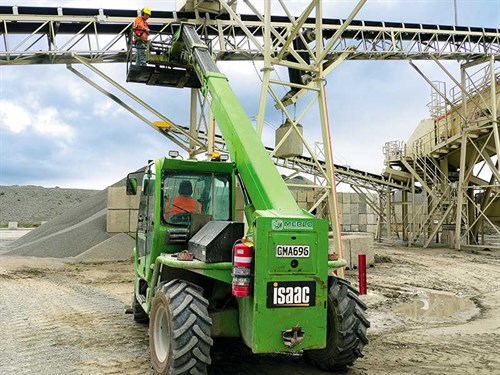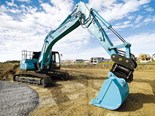Business profile: Isaac Construction


 Stuart Cameron
Stuart Cameron






|

|
|
Stuart Cameron
|

|

|
When Isaac Construction Ltd commissioned a new crushing plant for their Christchurch quarry, one of the items on the list was a telehandler, which would form a part of the servicing fleet. The Ed went to find out more.
The pedigree of Isaac Construction Limited goes back some 60 years in the Canterbury region, and even prior to the Christchurch rebuild, the large privately-owned business was a force to be reckoned with.
Background
Isaac Construction Limited was established by Sir Neil and Lady Diana Isaac in 1950. The forward-thinking couple transitioned the business’ quarry operations across to environmental well-being long before such catchphrases were trendy. The rehabilitation of worked-out areas of the Christchurch quarry now provides the public with more than 1000 hectares of conservation space for the study of native flora and fauna, not to mention ensuring longevity for the business and the many staff members families that it provided wages for.
As such, the founders established the Isaac Conservation and Wildlife Trust, which now owns the construction company and ensures that the principles set by Sir Neil and Lady Diana Isaac continue into the future.
The large quarry operation itself on the outskirts of the city has fed untold quantities of aggregate into the city over the years in the form of ready-mixed concrete, asphalt, as well as the many grades of crushed raw product needed for construction projects.
Crushing plant upgrade
Judging by the rough timeline that our host, maintenance supervisor Stuart Cameron, has given, I would say that the company anticipated the huge construction upswing associated with the Christchurch rebuild and invested heavily, replacing the existing quarry plant with a totally new system that was supplied by Mimico.
With such an extensive investment in place, regular servicing of it and the many other duties associated with running a large quarry operation required a machine that was versatile enough to carry all those different tasks safely and efficiently.

Merlo P38.12 telehandler
Enter the Merlo P38.12 telehandler. Supplied by Telelift in 2013, the Italian-built machine forms the backbone of the crushing plant service operations. On the day we visited, it had assisted with a tyre change on a wheel loader before moving some pallets and a quarry sign and then giving a conveyor drum a quick grease. "It is also used to move the concrete blocks that are made from the leftover ready-mix," says Stuart.
After a safety briefing, we are bundled off to have a look around the quarry itself.
"The uses of the machine for our operations are almost limitless. Sometimes, it seems that we have a new use for it each week," says our host.
Accurate load placement
A short while later we are at the quarry plant, inspecting a concrete block-walled large shed that holds fine aggregate that is used by the asphalting division.
"We built this whole thing with the Merlo," says Cameron.
"It’s all engineered, but we would have had a real struggle to put the thing up with any other type of machine."
The reason Stuart says this is because along with four-wheel steering (including the ability to crab), the Merlo P38.12 has boom side shift and frame levelling features. The boom side shift is actually a Merlo patent, allowing it to move laterally 530mm left or right. On the other axis, the frame levelling system allows the hydraulic cylinders between the chassis and front axle to move the chassis up to 10 degrees from level.
With the P38.12’s ability to lift up to a height of 12 metres or 7 metres along the ground, precision accuracy to place the blocks for the shed walls was attained by using either of the two movement features to fine tune the placement of each concrete block in exactly the right place.
"You don’t have to wriggle the machine around to hit the exact spot.
"When you are extended out, a few inches of side-shift at the machine end can translate to up to a metre, or sometimes more at the end of the boom," says Merlo operator John Schumacher.

Sure-footed stability
Also keeping things sure-footed are the ground stabilisers, which operate independently. These don’t extend past the width of the machine, so can be ideal for tight spots. Another bonus of the stabilisers is their ability to vertically raise the boom (via the frame levelling system) up to 24 degrees and adds another way to fine tune the placement of a load.
Versatility
John has been on the machine from day one and says that its versatility is ideal for the work that is carried out in the crushing division. "We also have a bucket for it, so we don’t need to call a loader down if we want to spread a bit of aggregate around the yard or move something in the bucket," he says.
Safe working
With such an investment at stake and huge machinery operating in the quarry, it is quite heartening to see that a fairly small machine forms quite an integral part of ensuring everything keeps working.
"Using equipment that is not suited to the job is something we don’t do and operating safely is a key consideration for everything we do. The Merlo’s versatility enables us to do that," says Cameron.
Use for the Merlo handler is high, with the machine clocking up around 1000 hours a year, which means it is something that is in demand and appreciated.
"It works well for us. I’d hate to think of not having it here," says Stuart.
For more information, contact Telelift 0800 853 538.
Keep up to date in the industry by signing up to Deals on Wheels' free newsletter or liking us on Facebook.















